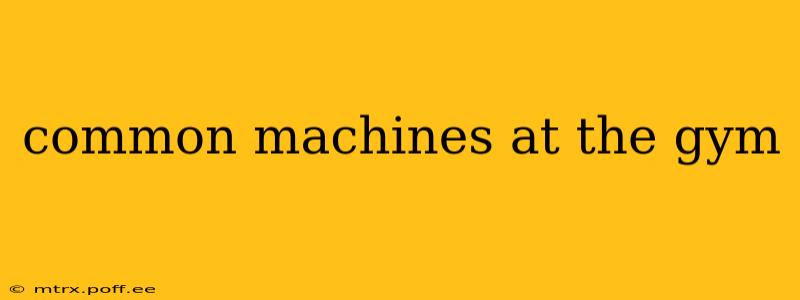Navigating the gym can feel overwhelming, especially with the sheer number of machines available. This guide will break down some of the most common gym machines, explaining their purpose, how to use them safely, and the muscles they target. Understanding these machines will help you build a more effective and safer workout routine.
What are the Most Common Gym Machines?
Many gyms offer a wide variety of machines, catering to different fitness levels and goals. Some of the most common include:
- Treadmills: For cardiovascular exercise, improving endurance and burning calories.
- Elliptical Trainers: A low-impact option for cardio, engaging both upper and lower body.
- Stationary Bikes: Another popular cardio machine, ideal for building leg strength and endurance.
- Rowing Machines: A full-body workout that strengthens legs, core, and back.
- Weight Machines: These target specific muscle groups with guided movements, minimizing risk of injury for beginners.
What are the Benefits of Using Gym Machines?
Gym machines offer several advantages:
- Guided Movements: Machines often guide your movements, reducing the risk of improper form and potential injuries. This is particularly beneficial for beginners.
- Targeted Muscle Activation: Many machines are designed to isolate specific muscle groups, allowing for focused training.
- Easy to Use: The clear instructions and setup of most machines make them accessible to a wider range of fitness levels.
- Progressive Overload: Most machines allow you to progressively increase weight or resistance, facilitating continuous strength gains.
What are Some Examples of Weight Machines and Their Uses?
Let's delve into some specific weight machines:
Chest Press Machine:
This machine targets the pectoral muscles (chest) and triceps. It provides a controlled movement, ensuring proper form and reducing the risk of injury compared to free weights.
Leg Press Machine:
The leg press machine is excellent for working the quadriceps (thighs), hamstrings (back of thighs), and glutes (buttocks). It allows for heavier weight than free weight squats, making it ideal for building lower body strength.
Lat Pulldown Machine:
This machine focuses on the latissimus dorsi muscles (lats), located in the back. It helps develop a wider back and improves posture.
Shoulder Press Machine:
The shoulder press machine targets the deltoids (shoulder muscles), improving shoulder strength and definition.
Leg Extension Machine:
This machine isolates the quadriceps muscles, offering a focused workout for the front of the thighs.
What are Some Common Mistakes to Avoid When Using Gym Machines?
- Ignoring Proper Form: Always follow the instructions and maintain correct posture to prevent injuries.
- Using Too Much Weight: Start with lighter weights and gradually increase as you get stronger.
- Rushing Through Reps: Focus on controlled movements to maximize muscle activation and minimize risk of injury.
- Neglecting Warm-up: Always warm up before using any machine to prepare your muscles for exercise.
- Ignoring Rest: Adequate rest between sets is crucial for muscle recovery and growth.
How Do I Choose the Right Gym Machines for My Goals?
The best machines for you will depend on your individual fitness goals. If your goal is to build muscle, focus on weight machines that target specific muscle groups. For cardiovascular health, prioritize treadmills, ellipticals, stationary bikes, or rowing machines. A balanced approach, incorporating both strength training and cardio, is often recommended for overall fitness.
What are Some Alternatives to Gym Machines?
While gym machines offer convenience and safety, many exercises can be performed using free weights (dumbbells, barbells) or bodyweight exercises. These alternatives often offer greater functional strength and can be adapted to different fitness levels. Consult a fitness professional to determine the best approach for your needs.
This comprehensive guide provides a solid foundation for understanding common gym machines. Remember to always consult with a qualified fitness professional before starting any new workout routine. They can help you create a personalized plan that aligns with your goals and fitness level, ensuring safe and effective results.
